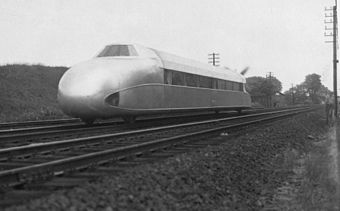| Schienenzeppelin | |
|---|---|
 Schienenzeppelin at Erkrath-Hochdahl steep ramp | |
 Rear view, showing the two-bladed propeller | |
| Manufacturer | Franz Kruckenberg |
| Built at | Hannover-Leinhausen (DR) |
| Constructed | 1929 |
| Scrapped | 1939 |
| Number built | 1 |
| Capacity | 40 people |
| Specifications | |
| Car body construction | Aluminum |
| Car length | 25.85 m (84 ft 9+3⁄4 in) |
| Height | 2.8 m (9 ft 2+1⁄4 in) |
| Maximum speed | 230.2 km/h (143.0 mph) |
| Weight | 20.3 t (20.0 long tons; 22.4 short tons) |
| Prime mover(s) | BMW VI |
| Engine type | Water-cooled V12 petrol aircraft engine |
| Cylinder count | 12 |
| Cylinder size |
|
| Power output | 600 hp (450 kW) |
| Transmission | Compressed air[1] (driving a propeller) |
| UIC classification | 2 |
| Track gauge | 1,435 mm (4 ft 8+1⁄2 in) standard gauge |
The Schienenzeppelin (German: [ˈʃiːnənˌtsɛpəliːn]) or rail zeppelin was an experimental railcar which resembled a Zeppelin airship in appearance. It was designed and developed by the German aircraft engineer Franz Kruckenberg in 1929. Propulsion was by means of a pusher propeller located at the rear: it accelerated the railcar to 230.2 km/h (143 mph) setting the land speed record for a petrol powered rail vehicle. Only a single example was ever built, which due to safety concerns remained out of service and was finally dismantled in 1939.
- ^ Traver Adolphus, David (December 2007). "Schiene Zeppelin". Hemming Motor News. Retrieved 23 March 2011.